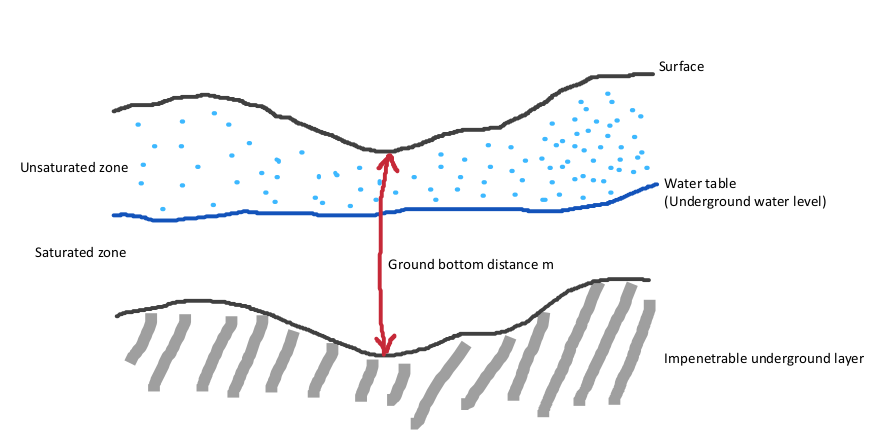Ground model (Water Overlay): Difference between revisions
No edit summary |
No edit summary |
||
| Line 1: | Line 1: | ||
[[File: | [[File:underground_model.png]] | ||
The water model includes an underground model which dictates the movement of water in the soil. The underground model includes the flow of water from the surface into the underground via infiltration, the flow of water from one underground location to another, and the exfiltration of water from the soil back onto the surface layer. | The water model includes an underground model which dictates the movement of water in the soil. The underground model includes the flow of water from the surface into the underground via infiltration, the flow of water from one underground location to another, and the exfiltration of water from the soil back onto the surface layer. | ||
Revision as of 14:15, 12 April 2019
The water model includes an underground model which dictates the movement of water in the soil. The underground model includes the flow of water from the surface into the underground via infiltration, the flow of water from one underground location to another, and the exfiltration of water from the soil back onto the surface layer.
The underground model can be explicitly activated or deactivated by setting the GROUND_WATER attribute of the water overlay to the appropriate value. If the underground model is deactivated, no water can move from or to the underground in any form, including underground evaporation.
The underground is bounded vertically by the surface of the terrain at the top, and an assumed impenetrable layer at the bottom. The distance between the surface and the impenetrable layer, and thus the effective height of the underground, is equal to GROUND_BOTTOM_DISTANCE_M. In other words, the impenetrable underground layer is assumed to be a set distance below the surface. The distance is uniform across the entire project area, and follows the profile of the surface.
The underground is composed of 2 layers: the unsaturated zone and the saturated zone. The saturated zone is the region of the underground where the soil is saturated with water. This water is assumed to work as a continuous volume of water able to flow horizontally. The unsaturated zone is the region of the underground above the saturated zone. The edge between the unsaturated and saturated zone can be considered the groundwater level.
The groundwater level, and thus the height of the saturated zone, is determined both by the amount of water in the saturated zone, and the underground terrain's WATER_STORAGE_PERCENTAGE. The lower the water storage percentage of the soil, the greater the volume of soil that is saturated by the same amount of water, and thus the higher the the groundwater level will become.
The underground water level is initialized with the values of the ground water GeoTIFF connected to the water model. If no ground water data is connected, the ground water level relative to datum is equal to the surface water level relative to datum, as defined by the WATER_LEVEL attribute of the water level area in that location.
When water infiltrates from the surface, it infiltrates at a speed dictated by the surface terrain's GROUND_INFILTRATION_MD attribute, the underground terrain's GROUND_INFILTRATION_MD attribute, or (if present) by the construction's GROUND_INFILTRATION_MD, whichever value is lowest. The least porous material present will always serve as a bottleneck for the water to flow through, even if the other layers allow for a high rate of infiltration.
Surface water infiltrates into the underground unsaturated layer. Water in the unsaturated layer is assumed to be spread equally across the entire unsaturated volume. Water then flows from the unsaturated zone into the saturated zone at the speed dictated by the underground terrain's GROUND_INFILTRATION_MD. For a given timestep, the distance the water travels is determined. The amount of water that flows from the unsaturated zone to the saturated zone is equal to the amount of water in a section of the unsaturated zone the height of which is equal to that distance. After water has been added to the saturated zone, the groundwater level (and thus the height of the saturated zone) is redetermined. The water in the unsaturated zone is redistributed uniformly across the (remaining) unsaturated zone.
Water stored in the underground saturated zone can flow horizontally from one underground cell to another, if the groundwater level relative to datum is higher than the neighboring cell's ground water level, relative to datum. The amount of water which can flow from one cell to another is dictated by the underground terrain's GROUND_INFILTRATION_MD.
Water stored in the underground saturated zone can also exfiltrate out of the underground and back onto the surface, if the groundwater level relative to datum exceeds the neighboring cell's surface water level relative to datum. The amount of water which can flow from the underground of one cell onto the surface of an adjacent cell is dictated by the underground terrain's GROUND_INFILTRATION_MD.
